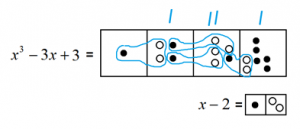Exploding Dots
6.6 (Optional) The Remainder Theorem
High school teachers have asked me if the dots and boxes approach can be used to explain the “Remainder Theorem.” This optional section is for anyone interested in learning about the mathematics of this piece of extra-advanced polynomial algebra.
Let’s examine \(\dfrac{x^{3}-3x+3}{x-2}\). This is the polynomial \(p(x)=x^{3}-3x+3\) divided by the linear polynomial \(x-2\).
Here’s the picture I get when doing this in an \(1 \leftarrow x\) machine. I had to add in some of dot/antidot pairs.

We see that \(\dfrac{x^{3}-3x+3}{x-2}=x^2+2x+1+\dfrac{5}{x-2}\). There is a remainder of \(5\), a number.
Look at the picture of \(x^{3}-3x+3\) carefully, taking note of the loops.
We see one loop at the \(x^2\) level, two at the \(x\) level, and one at the ones level. Plus we see a remainder of \(5\). As each loop represents the quantity \(x-2\), this means that
\(p(x)=x^{3}-3x+3=\left(x-2\right)\times x^2 + 2\left(x-2\right)\times x + \left(x-2\right) \times 1 +5\).
[We can also obtain this simply by multiplying our result \(\dfrac{x^{3}-3x+3}{x-2}=x^2+2x+1+\dfrac{5}{x-2}\) through bey \(x-2\).]
So
\(p(x) =\left(x-2\right)\left(something\right)+ 5\).
That “\(+5\) ” is standing out like a sore thumb. If you put in \(x=2\) we get
\(p(x) = 0 + 5\).
In general, dividing a polynomial \(p(x)\) by a term of the form \(x-h\) will give
\(p(x) =\) multiples of \(\left(x-h\right) \;+ r\).
where \(r\) is a remainder. Putting \(x=h\) shows that \(p(h)=r\).
This is the Remainder Theorem for polynomials.
Dividing a polynomial \(p(x)\) by a term \(x-h\) gives a remainder that is a single number equal to \(p(h)\), the value of the polynomial at \(x=h\).
People like this theorem because it shows that if \(p(h)=0\) for some number \(h\), then \(p(x)\) is an multiple of \(x-h\). (The remainder is zero.) This gives the Factor Theorem for polynomials.
A polynomial \(p\) has a factor \(x-h\) precisely when \(h\) is a zero of the polynomial, that is, precisely when \(p(h)=0\).
This is a big deal for people interested in factoring.
Resources
Books
Take your understanding to the next level with easy to understand books by James Tanton.
BROWSE BOOKS![]()
Guides & Solutions
Dive deeper into key topics through detailed, easy to follow guides and solution sets.
BROWSE GUIDES![]()
Donations
Consider supporting G'Day Math! with a donation, of any amount.
Your support is so much appreciated and enables the continued creation of great course content. Thanks!
Ready to Help?
Donations can be made via PayPal and major credit cards. A PayPal account is not required. Many thanks!
DONATE![]()


